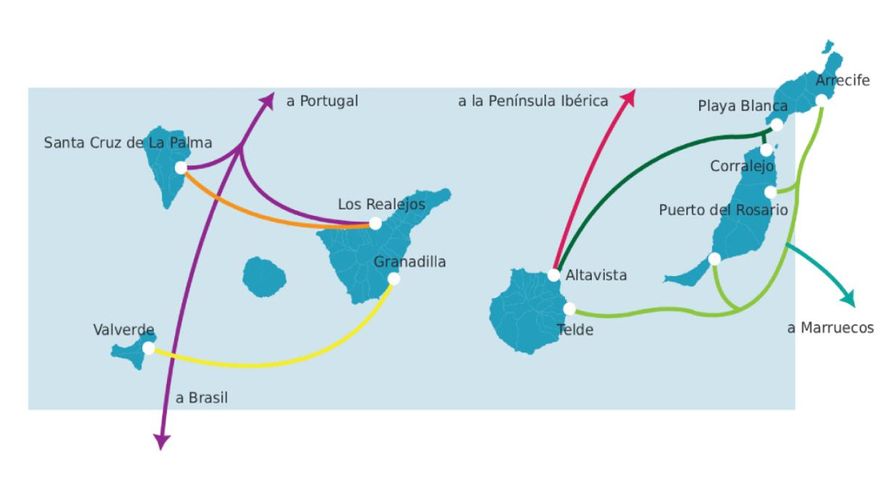The Canary Islands: A New Digital Nexus
The Canary Islands are positioning themselves as a vital digital link between Europe and Africa. The archipelago is currently immersed in an ambitious project to install a new submarine fiber-optic cable that will significantly strengthen Atlantic connectivity. This infrastructure will create a direct link between the Islands and Morocco, establishing the Autonomous Community as a strategic node for electronic communications between continents.
Breaking the Monopoly: The Birth of Canalink
The project originated with the creation of the company Canalink, which was founded with the explicit goal of “breaking the communications monopoly” in the Canaries, explains Juanjo Martínez, the Minister of Innovation for the Tenerife Council. Within this framework, Canalink has established itself as one of the country’s leading submarine cable operators, with a network that connects the archipelago to both Europe and Africa.
Its existing infrastructure includes inter-island cables connecting Tenerife with Gran Canaria and Tenerife with La Palma, as well as a dual-cable system linking Tenerife and Gran Canaria to Rota in Cádiz. This network is set to expand with future cables that will connect the eastern islands to Morocco, alongside an upcoming deployment of a new submarine cable that will finally link Tenerife with El Hierro.
A Strategic Investment in Connectivity
With a total investment of €13.5 million—€7.5 million of which comes from European funds—the Morocco submarine cable is the Canaries’ bet to enhance its connectivity and position itself as a competitive international player. This strategy gains particular relevance in a scenario marked by growing geopolitical tension, where technological sovereignty is of strategic value to territories.
By channeling traffic from southern Morocco through the Canary Islands for subsequent global distribution, the project not only increases the strategic value of the archipelago’s existing infrastructure but also creates a “call effect,” attracting future investments interested in leveraging an increasingly “more robust” network, as highlighted by Canalink.
Boosting Digital Autonomy and Resilience
The technological challenges facing the region are substantial, forcing institutions to focus their efforts on guaranteeing digital autonomy. “We have managed to ensure the Islands have a level of connectivity equivalent to any mainland territory,” emphasizes Minister Juanjo Martínez. This situation will be further reinforced with the installation of the new submarine cable, which will be located less than 100 kilometers from the Islands.
The contract for its development has already been awarded, and the cable manufacturing is underway. Furthermore, studies have been carried out in Tarfaya—the Moroccan city through which the infrastructure will pass—to determine the optimal connection point. The cable-laying process is scheduled to begin in the second quarter of 2026.
Forging New Partnerships in Africa
Meanwhile, the Tenerife Council is working to find strategic partners in Morocco to help position this connection in the African market. “This opens an opportunity to commercialize the services we will offer from the Canaries, which will benefit both the archipelago and the African continent by providing a new connectivity route: from Africa, through the Canaries, to the rest of the world,” Martínez points out.
Guaranteeing Reliability in a Crisis
One of the most notable aspects of the project is the guarantee of communication redundancy. This approach seeks to minimize the impact of potential interruptions by allowing traffic to be rerouted via alternative paths in case of a failure. This capability is especially relevant in crisis contexts, such as power blackouts.
“During the blackout, operators using Canalink’s networks were able to maintain service because the systems remained operational on the Peninsula,” explains Minister Juanjo Martínez. Of the four main operators present on the Peninsula, three managed to maintain connection at all times. Therefore, “having an island communications network with multiple submarine cables will always improve resilience against outages.”
A Privileged Position for Future Growth
In this type of scenario, strengthening relations with Africa acquires greater strategic relevance. “It places us in a privileged position. We already have clients in Mauritania; in fact, the country’s main operators use the Canalink network,” highlights the minister. The goal is to continue boosting the international profile of the region and open new business opportunities in the digital sphere.
After all, submarine cables are responsible for transporting over 99% of global internet traffic, making them a critical infrastructure for the economic and technological development of any region. Without these cables, the internet “as we know it would not exist, as it would be more expensive, slower, and limited in capabilities,” maintain sources from Canalink.
Navigating Challenges and Looking Ahead
The initiative has not been without its challenges. The new cable passes through waters near Western Sahara, whose sovereignty remains disputed. To date, the Sahrawi people have not given their approval for the project, meaning a potential extension of the connection to the Sahara could lead to legal complications.
The project does not stop at Morocco. The Tenerife Council is simultaneously working on creating a neutral access point in the Canaries. This key solution would help keep the entire network of connections within the archipelago operational in the event of an energy blackout or other interruptions on the mainland. Even if external communications were compromised, services in the Canaries—especially emergency services—could continue to function locally.
In the realm of digital communications, the next steps must focus on promoting investment in projects that “broaden horizons and improve the infrastructure and resilience of the archipelago’s telecommunications networks.” This includes focusing on key initiatives such as the development of data centers, the implementation of satellite teleports, and the strengthening of terrestrial fiber backbone networks. All these factors, together, “will contribute to more efficient connectivity” in the region.

